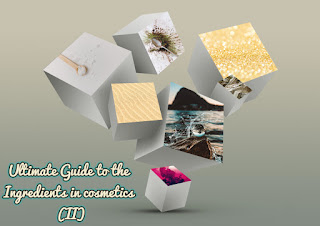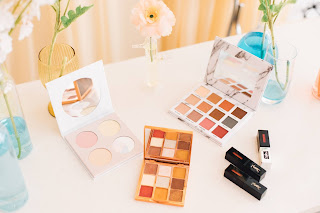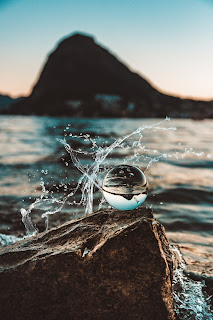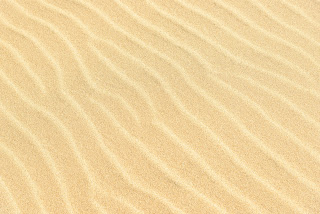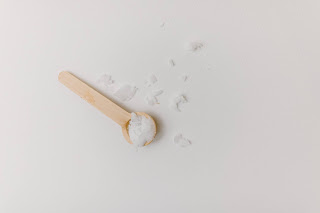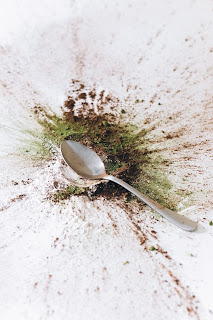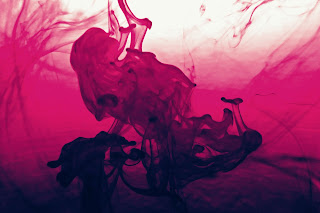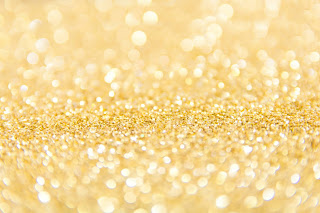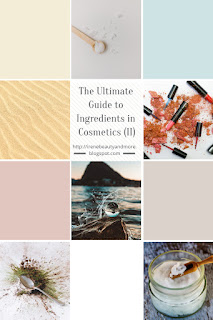The Ultimate Guide to the Ingredients in Cosmetics (II)
If you normally read the ingredient list of the products you use, you should know that most of the cosmetics have between 15-50 ingredients on the list. If we think about makeup and skincare, on average, we can use between 9 to 15 products each day. That means we use around 500 ingredients per day. Quite a lot…..
In the first part of this series (you can read it here), I mentioned that all the ingredients in the ingredient list or INCI are part of at least one of these groups: active ingredient, excipients, and additives. The active ingredients are the ingredients producing the main function, the one the brand claims for. It can be a moisturizing, anti-ageing, sunscreen, alpha-hydroxiacid,… I am not going to talk about them, each ingredient deserves a post and I am planning a series about active ingredients.
I mentioned in part I excipients, which are responsible for the cosmetic texture and additives, responsible to preserve the cosmetic or change any of its properties as smell, colour, etc. But what are them exactly? How many types of excipients and additives are?
I am going to classify them depending on their function as a solvent, emulsifiers, preservatives, thickeners, emollients, colourants, fragrances, pH stabilisers and propellants. Let’s go through each type.
Solvents
The role of the solvent is to dissolve other ingredients, mainly solid ingredients. Most of the non-solid cosmetics contain solvents and in some cases, it is the first ingredient on the INCI.
The most common solvent is water, obviously not tap water, but deionized and purified water. Water is the base of lots of cosmetics as creams, lotions, deodorants, shampoos, etc. For example, if you check the INCI of toner, you will see that water is the first ingredient.
Though it is the most common solvent, water is not unique. Alcohol is also a very common solvent and you can find it as ethanol, propanol, IPA, alcohol denat, or simply alcohol. Alcohol is the main ingredient of perfumes but some other product can contain alcohols, like toners and deodorants.
Emulsifiers
They are also called Emulgent and Surfactant.
As you are aware of, water and oil don’t mix together. In many cosmetics, it is normal to have water-based and oil-based ingredients and, because of the nature of these ingredients, they will not mix and, if you try to mix them, they will separate and fall apart. However, your creams are a well-homogenized product. Here is where the job of emulsifiers starts, keeping together ingredients that normally will not mix together. They form what is called an emulsion.
There are two types of emulsions, droplets of water dispersed in oil or droplets of oil dispersed in water. The emulsifiers produce a homogeneous mixture in both cases. The typical example of emulsions is the case of the creams. Any cream you use is an emulsion.
The most common emulsifiers you can find in the formulas are polysorbates, lecithin, stearic acid, sodium laureth sulfate, sodium lauryl sulfates and waxes.
Preservatives
Nothing lasts forever and cosmetics are not an exception. Once you open the product it can suffer different processes as oxidation as a consequence of air or microorganism growth (bacteria and fungi) which make your cosmetic dangerous for your skin.
Preservatives are added to the cosmetics to extend their shelf-life. There are two main groups of cosmetics, antioxidants and antibacterial/antifungal.
Preservatives are very important in water-based products. Their tendency to oxidise and grow microorganisms is higher than in another type of cosmetics. Powder cosmetics also have preservatives, but because of their nature, they have a longer shelf-life by themselves.
Keep in mind that all the cosmetics sold as preservative-free have a shorter shelf-life and you should keep an eye to any change in texture, smell, appearance, etc.
Example of the most common preservatives are EDTA, parabens (they are not very popular and I will write a post about them), sorbates, glutamates.
Thickeners
Sometimes it is necessary or convenient to change the consistency of a product. Here is where thickeners are involved, they increase consistency, viscosity or density of a product without modification of its properties.
There are different type of thickeners:
Lipidic thickeners: They are solid at room temperature but become liquid when they are gently heated. That is the case of cetyl alcohol, stearic acid or carnauba wax.
Naturally derived thickeners: This type of thickeners come from nature. They are normally polymers which swell up when absorbing water. That effect produces an increase in the consistency of the product. Some of the most used naturally derived thickeners are hydroxyethylcellulose, xanthan gum, gelatine or agar-agar.
Mineral thickeners: These thickeners are also natural, but they work in a different way. They absorb water and oil and increase viscosity while doing that. The result is different compared with the polymer thickener.
Examples of these thickeners are magnesium aluminium silicates, silica and bentonite.
Synthetic thickeners: They are not natural, they are man-made. They are frequently used in lotions and creams and the most popular is carbomer, which is an acrylic polymer which forms clear gels.
Thickening is a reversible process. If a product is too thick it is possible to reduce the thickness by adding solvent, like water, which may reduce the consistency of the product. Do not do that at home.
Emollients
Emollients are ingredients which avoid the loss of water from the skin, keeping it hydrated. Most of the hydrating and moisturizing creams contain emollients.
They can be natural and synthetic. Some examples of emollients are beeswax, olive oil, coconut oil, lanolin, petroleum jelly, mineral oil, glycerine, paraffin, …
Colourants
Makeup products are where we find more quantity and variety of colourants. They are normally mineral ingredients, each one giving a different colour as shown in the table below:
Pigment | Colour |
Iron Oxides | Black, Yellow, Red |
Chromium dioxide | Dull Olive Green Blue Green Bright Green |
Ultramarines | Bright Blue to Violet, Pink and Green |
Manganese Violet | Violet |
Ferric Ferrocyanide | Deep Intense Blue |
White Pigments (Titanium Oxide and Zinc Oxide) | White |
Sometimes the pigments come from a vegetable source as beetroot powder, spirulina,…
Colourants can be classified in:
Inorganic: They are normally insoluble metallic compounds found in natural sources (China clay, carbon deposit) but can be also synthetic. Based on the composition they are divided into iron oxides, zinc oxides, carbon blacks, chromium oxides green and ultramarines. They are not water-soluble and most of the time they are used on solid makeup. They don’t present a great variety of shades.
Organic: From the chemical point of view, that means a hydrocarbon chain containing different functional groups but not containing metals. They are synthetic most of the time and chemically they are very complex molecules as indigoids, azos, nitros,…They can provide a huge variety of shades. They are soluble and can be dispersed in other substances as castor oil.
Mica: They are fun colours with a range beyond the rainbow. They can be mixed to create fantasy. Untreated they are transparent and they are part of the glitter and shimmer I will mention later. Sometimes they are coated onto iron oxide and titanium oxide pigments and topped with additional layers of other materials.
Glitter and Shimmer
These type of ingredients are very common in makeup products like highlighters, bronzers, blushes, eyeshadows, lipsticks,… Basically, they are particles that reflect light.
Most common compounds used are mica and bismuth oxychloride.
Mica comes from muscovite (KAl2(AlSi3O10)(F,OH)2). It forms sheets which are crushed into a fine powder which is the form used. This powder refracts light creating a shimmering effect. Mica produces an iridescent effect.
Bismuth oxychloride (BiClO) can be found naturally but it is normally synthesized. Bismuth oxychloride creates a silver-grey pearly effect.
Glitter and shimmer are both the same things and the difference between them is only the particle size. Shimmer present a small particle size (15-60 um) and glitter uses particles bigger than 500 um.
Fragrances
The smell of the cosmetic is very important. I tell by my experience, as I am chemist, that most chemicals have a really disgusting smell and you don’t feel like applying on your face.
Fragrances are chemicals or a mixture of chemicals added to a cosmetic to modify the smell and mask undesired odours.
Normally all the ingredients used as fragrance are not listed in the INCI. They mention something called “FRAGRANCE” which includes a huge variety of chemicals, most of the time a brand’s secret formula.
Propellants
We find that type of ingredients in spray or aerosol products. A spray is a colloid of small liquid droplets suspended in air or other gas. Without propellant, it is not possible to get a spray.
Most common propellants are butane, carbon dioxide, dimethyl ether, ethane or nitrogen.
As you can seem, there are a lot of chemicals in a single product, each one having a role which makes the product be what it is, smell as it does and have the properties it claims for. We should not be scared or concerned about these chemicals because there is a very clear regulation about what can be used and how much can be used. They are really safe.
Continue using them and enjoy your cosmetics. Feel free to ask any doubt in the comments.
Bear in mind that some of the links in this post are affiliate links and if you go through them to make a purchase I will earn a commission. Keep in mind that I link these companies and their products because of their quality and not because of the commission I receive from your purchases. The decision is yours, and whether or not you decide to buy something is completely up to you.
